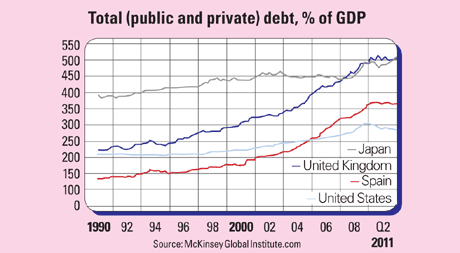
The process of working off debt, or deleveraging, “is proving to be long and painful”, says a report by the McKinsey Global Institute. That’s just as historical experience suggested it would be. Two years ago, McKinsey studied 32 post-1930s examples of deleveraging following financial crises. It found that it took the average country six or seven years to lower its total (public and private) debt-to-GDP ratio by 25%.
Today, McKinsey finds that the world economy has made little progress. In seven of the world’s ten biggest economies, the overall debt pile (in other words, adding corporate debt, household debt and government debt together) has risen since the crisis. That’s largely due to rising government borrowing, which reflects stimulus spending both during and after the crash. In Britain, total debt is now 507% of GDP. Only in America, South Korea and Australia has total debt fallen.
In America, financial-sector debt has fallen back to levels last seen in 2000, before the credit bubble inflated. Household debt is down to 87% of GDP, and has fallen by 15% relative to disposable income. At the current rate, US household debt would return to sustainable levels (defined as the pre-bubble long-term growth rate of debt to income) in two years.
In Britain, the picture is less encouraging. Government borrowing has risen sharplyand non-bank financial companies have issued more debt too. Household debt has only fallen marginally as a proportion of GDP and has risen in absolute terms.
British banks have also been generous in “granting forbearance to troubled borrowers”, says McKinsey. Up to 12% of home loans are in a forbearance process, according to the Bank of England. In the US, by contrast, defaults on mortgages and consumer debt account for two-thirds of household debt reduction. “It is a crude way to deleverage, but at least it brings matters swiftly to a head,” says Ambrose Evans-Pritchard in The Daily Telegraph. In Britain, the process is being strung out.
“At the recent pace of debt reduction, we calculate that the ratio of UK household debt to disposable income would not return to its pre-bubble trend for up to a decade,” says McKinsey. Years of deleveraging still lie ahead for most developed economies, and the debt load will continue to hamper growth and equity markets.